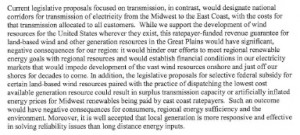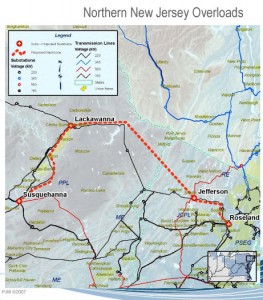PSE&G Discovery – Susquehanna-Roseland line
May 17th, 2009
It’s been a busy couple of weeks, with Discovery to and fro with PSE&G. Here’s the results:
This is their response to the BPU Discovery. Although Ken Sheehan at BPU had said we could proceed with Discovery before we were parties, we’d sent the blanket request for others’ requests to avoid duplication and find out where we were at, but they ignored it, and even BPU would not forward their requests… so we sat in the dark until after our intervention was formally granted. I asked again, and lo and behold, that same day, BPU turned over their requests and PSE&G turned over their respones to BPU Discovery. Many of the responses aren’t, so I imagine there’ll be some wrangling about that.
Here’s what we’ve sent to them so far:
The Discovery deadline for the Direct Testimony has been extended to June 5th.
Are we having fun yet?
Eastern Governors stand up against Transmission!!!
May 6th, 2009
Yeaaaaaaaaaaaa! One for the home team!!!!
First it was NYISO and ISO-New England:
Then it was New York’s Deputy Secretary of Energy testifying before Senate Energy Committee:
And now the Governors from the Northeast and Mid-Atlantic states have stood up against the insane Midwest transmission plans — transmission plans like CapX 2020, JCSP/MTEP, Green Power Express, and the unnamed group announced on April 3rd, starting in North Dakota, banding southern Minnesota, and shooting out into Wisconsin.
Here’s their letter:
It’s blurry, so click the letter and read the whole thing. An eye opener for the Midwest, those who don’t recognize that there’s a big world out there and it’s not all about Midwest wind. Folks, you have a marketing problem, your target market says NO! What about NO can’t you understand?
The Economist weighs in, now it’s YOUR turn!
May 4th, 2009
I’d wondered why “The Economist” had shown up in my blog stats, and now I know. But from the viewpoint of this article, it’s clear they didn’t do more than scratch the surface of transmission in the Midwest. This is “party line” all the way — I hope they’ll now take the time to read NYISO and ISO-NE’s letter of withdrawal from publication of JCSP!
YOUR TURN! Let them know what you think and why — the registration is instantaneous and easy, so COMMENT AWAY!
Spreading green electricity: A gust of progress
Apr 30th 2009 | CHICAGO
From The Economist print edition
Susquehanna-Roseland Xmsn Interventions OK’d
April 29th, 2009
Day before yesterday, New Jersey’s Board of Public Utilities met to make determinations on the Motions for Intervention of a large number of parties. Stop the Lines, of course being one! They’d objected to our Intervention:
… but had no objection to my Pro Hac Vice… go figure. And the feeling I had from the BPU is that they were honestly encouraging interventions. SO, what happened?
State: 17 groups may intervene in PSE&G’s power line proposal
By Colleen O’Dea • Daily Record • April 27, 2009All 17 groups that sought to be part of the hearing process on Public Service Electric and Gas Company’s proposed transmission line project may do so, the state Board of Public Utilities decided today.
Meeting in Newark, the board also directed PSE&G to meet with the intervening parties – several municipalities, environmental organizations and citizens groups – to negotiate an agreement on the establishment of an escrow account from which the groups could pay for expert witnesses.
“Super,” is how Dave Slaperud of the 300-member Stop the Lines, one of six groups the utility had sought to bar from intervening in its application to add 500 kilovolt lines along a 46-mile transmission corridor from Pennsylvania through Morris County to Roseland, described the BPU’s decision.
“We would have been really surprised if we had been denied intervener status,” said Slaperud. “There are so many of us living along the line who are affected and not all the municipalities are getting involved in the process.”
Among the government bodies that are involved are East Hanover, Montville, Parsippany and Byram townships and the Montville Board of Education. Interveners are allowed to request discovery documents, cross examine witnesses and present their own expert testimony.
And more:
Groups cleared to speak at powerline hearings
Xcel’s applied for Hiawatha Project
April 28th, 2009
HEY MOES, I’D SIGNED UP FOR THE LIST AND AS OF TODAY, 4/28, HAVE NOT RECEIVED NOTICE OF THIS PROJECT APPLICATION THAT YOU’VE POSTED ON APRIL 24! WHAT GIVES?
Here’s the state’s routing webpage – HERE’S THE LINK FOR APPLICATION AND TO SIGN UP FOR FURTHER INFORMATION:
Now take a look at this map for the FULL plan, well, at least a larger picture, than what they’re disclosing for the Hiawatha Project. Here’s the map, and note carefully, from B-C is what they’re calling the Hiawatha Project. tHIS SECTION IS FOR XCEL’s PAM RASMUSSEN, WHO HATES IT WHEN I PUBLISH THIS MAP, SO I’VE GOT TO BE VERY SPECIFIC WHERE THIS INFORMATION IS COMING FROM AND WHAT CONSTITUTES THE “HIAWATHA PROJECT” and as far as Xcel is disclosing, the applied for Hiawatha Project is “B-C” of this map. Look below to see where the rest comes from!
Here’s the NM-SPG meeting minutes reporting on the A-B link, the 345kV line from a new substation on Hwy 280 (A) to the new Hiawatha Project substation (B).
Then there’s “Hiawatha Project” from B-C.
For C, D and E, see the “Minnesota Transmission Owners” 2007 Biennial Transmission Plan, where they list these extension alternatives:
Alternatives. Initial investigation and scoping discussions have led to the development of three potential alternatives:
(1) Construct a new 115 kV line from a new Hiawatha Substation along Highway 55 to a new Oakland Substation near Lake Street and I-35W. The line would then continue south to a new Highway 62 Substation near Highway 62 and Nicollet Avenue. The line would continue to its final termination at a new Penn Lake Substation near I-494 and Sheridan Avenue.
(2) Similar to Option 1, but the final 115 kV line would stretch from Highway 62 Substation to the existing Wilson Substation near I-494 and Wentworth Avenue.
(3) Construct two smaller 115 kV loops with new 115 kV lines running from Hiawatha to Oakland to Elliot Park and a second loop from Penn Lake to Highway 62 to Wilson.
Section 7 of Biennial Transmission Plan, go to Section 7.5 and all the way down to 3rd and 4th to last pages:
Another point to note: the Hiawatha Project is WAY over spec’d. This is a double circuited ACSS 795kCmil conductor — see what that means and compare it with the claimed 100MW need in the FUTURE!
And now, for today’s STrib article:
Will burying power lines in Midtown bury city, users with $12.6 million bill?






